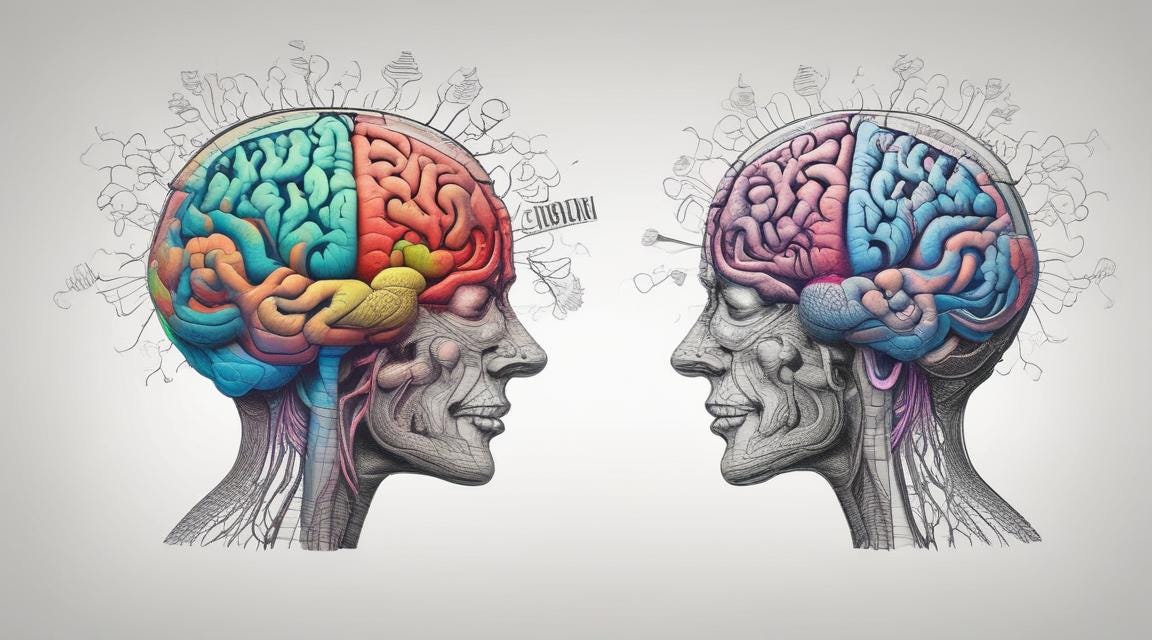I used to spend many moments staring at a screen or having my cursor blink away without typing a word.
Sometimes, I wished for an idea to come to mind.
I’ve lost count of the time I’ve been in that situation.
Writer's block has been my every-other-day moment and always haunts me.
However, everything shifted when I uncovered the influence of right-brain thinking and how it could significantly enhance my creativity and storytelling prowess.
Let’s Get Brain Science-y For a Minute
Let me first look at the critical differences between our skulls' left and right sides.
The left brain is often called the analytical or logical brain. The taskmaster handles things like language, reasoning, numbers, and organizing.
The right brain, on the other hand, is hub to creativity, intuition and emotions.
Now, both sides of the brain work together as a team, but most people tend to lean more heavily on one side over the other.
I was a full-blown left-brain loyalist, acing grammar, structure, and organization tasks for the longest time.
But when cooking fresh ideas and letting my imagination run wild, I always hit a brick wall.
Reading is one habit you can cultivate, literally right now, to improve your concentration — Sufyan Maan, M.Eng
It wasn’t until I started engaging my right brain that I truly experienced a full-on creative renaissance.
My Journey to Right-Brain Enlightenment
Switching to more right-brain thinking didn’t happen overnight.
It was a gradual process that took consistent practice and much patience.
Here’s how I slowly but surely trained my brain to get its creativity on:
Visuals, Visuals, Visuals: Instead of just staring at words on a page, I started using visualization as a regular part of my writing routine. I’d close my eyes and vividly imagine scenes, characters, plot lines — the whole nine yards. Creating mental images kickstarted my right brain’s awareness and allowed me to tap into those imaginative powers.
Let It Flow: Freewriting was a total game-changer. By setting a timer and writing without stopping to edit or judge, I could bypass my analytical left brain gatekeeper and let my creative right brain just let loose.
Mind Maps for the Win: Mind mapping is an incredible visual brainstorming technique that encourages you to think outside the box. It allowed me to explore ideas freely instead of getting locked into an overly logical, sequential thinking mode.
The more I consistently utilized these right-brain strategies, the more I noticed an incredible shift in my approach to writing.
Ideas began pouring out of me with much greater ease.
My stories became more affluent, imaginative, and packed with genuine emotions.
It's time for Some Story Time.
To give you a clearer picture of how right-brain thinking works its magic, let me walk you through three examples of how I’ve put it into practice:
Example 1: Characters That Jump Off the Page
One area where right-brain thinking has been game-changing is character development.
Instead of just giving dry physical descriptions or backstories, I’ve learned to tap into the complex emotional depths of my characters.
I’m was writing a scene with a character struggling through intense grief.
Rather than just telling you they’re sad, I’ll close my eyes and imagine the raw, gut-wrenching emotions they’d be feeling.
I’ll visualize the tears rolling down their cheeks, the heaviness in their chest, that the person felt during his/her loss.
Example 2: Worlds That Come Alive
Using right-brain thinking has also helped me build imaginative worlds that leap off the page.
For fantasy content set in a forest, I didn’t just say, " There were oak trees and ferns everywhere.”
I imagined how that bright sunlight would filter through the canopy in a kaleidoscope of warmth. I thought about the earthy, comforting scent of decaying leaves and rich soil. I visualized how the moss would feel calm and spongy under my characters’ feet.
Example 3: Twists and Turns Galore
Finally, right-brain thinking has been essential for crafting unexpected plot twists that blindside readers in the best possible way.
By learning to let go of my left brain’s attachment to order and logic, I’ve been free to explore delightfully unconventional story arcs.
This crazy twist kept readers hooked, injecting the narrative with more emotional depth and complexity.
Finding the Right Balance.
As much as we writers need our imaginative juices flowing, we still rely on our left brains for things like:
Outlining and structuring our stories cohesively.
Editing and polishing to ensure our writing makes logical sense.
Handling nitty-gritty tasks like grammar and fact-checking.
By finding that sweet spot, we can operate at our full creative potential and write stories that blow minds and make a powerful emotional impact.
The Neverending Creative Journey.
Overcoming writer’s block and finally unleashing my creativity was one of the most empowering, life-changing experiences ever.
Learning to engage my right brain through visualization, freewriting, mind mapping, and other techniques quite literally broke through mental barriers I didn’t even know existed.
Of course, this is just the start of my creative journey.
As I keep exploring and refining my right-brain strategies, I can’t wait to see where my imagination takes me next.
So the next time you find yourself staring at that blinking cursor, take a breath, engage that creative right brain, and let those innovative juices start flowing!



